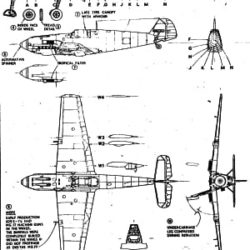Messerschmitt Bf 109E “Emil” History
Essentially similar to its predecessor aft of the firewall, the Messerschmitt Bf 109E “Emil” incorporated a completely redesigned lower cowling section into which the oil cooler was moved; the chin radiator was moved to the wings where two shallow glycol radiators were provided. As with the C and D, E-1 armament was standardized on a pair of cowling-mounted MG 17s and a pair of wing-mounted MG 17s. Surprisingly, even though pilot armor protection was encountered in the Russian I-16 over Spain, no such protection was provided for either pilot of fuel tankage.
The D version of the Bf 109 would have been a formidable fighter but for the unreliability for its engine. The V-14 aircraft, prototype for the E version, was powered by the new Daimler Benz DB 601 engine.
As badly as the Luftwaffe needed the new fighter, the Reich apparently needed hard currency more. During the winter of 1938-1939 Switzerland was allowed to purchase 10 Jumo-powered Bf 109s and placed an order for thirty Bf 109E-1s On April 1939, the first Messerschmitt Bf 109E “Emil” aircraft were delivered and Swiss authorities, obviously very impressed with their new machines, supplemented their previous order for an additional fifty.
During the whole of 1938, Bf 109 production just barely crept over the 400 mark. However, with the introduction of the DB powered E series the production tempo increased to such an extend that nearly 1100 aircraft were delivered during the first eight months of 1939. During this period, fighters were being delivered almost faster than the Jagdgruppen coult absorb them. The Luftwaffe at last had its first-line fighter, a fighter that was equal or better than any fighter in the world, a fighter that certainly was better than anything manufactured in continental Europe, a fighter with which Germany could go on war. Eventually, with production of the Bf 109 running about 130 per month, the Messerschmitt Bf 109E “Emil” rapidly replaced the earlier versions of the fighter, then serving with many of the front line units.
On 23 August, Germany and Russia publicly signed an non-aggression pact, in which they secretly divided up Poland. Eight days later, Germany struck across Polish borders with massive air and land forces.
The Luftwaffe Quartermaster General’s list for 2 September 1939, the day following the invasion of Poland, reveals that the force had 1,081 Bf 109s on strength, on which 979 were serviceable. At that time, some 24 fighter Gruppen and five Staffeln were equipped with the Bf 109. The most numerous versions in service was the Messerschmitt Bf 109E “Emil”, which equipped 15 Gruppen. At this time, seven Zerstoerergruppen operated Bf 109Bs, Cs and Ds on a temporary basis, until their intended Bf 110 twin-engined fighters became available; the remaining units operated Bf 109Cs.









